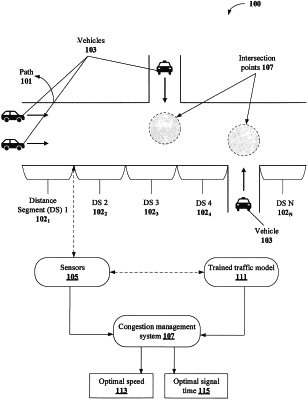| CPC G08G 1/0145 (2013.01) [G05D 1/0291 (2013.01); G06N 20/00 (2019.01); G08G 1/0116 (2013.01); G08G 1/0129 (2013.01); G08G 1/052 (2013.01); G08G 1/096725 (2013.01)] | 18 Claims |

|
1. A method for reducing road congestion, the method comprising:
selecting, by a congestion management system, a path by identifying one or more distance segments and one or more predetermined intersection points along a selected stretch of a road, wherein the selected path is indicative of a signal-free path without any stoppage of the plurality of vehicles within the selected stretch of the road;
receiving, by the congestion management system, traffic data related to a plurality of vehicles, for each distance segment and each predetermined intersection point on the selected path of the road, from one or more sensors deployed along the selected path,
wherein, for each distance segment and each predetermined intersection point,
the traffic data comprises current location of each vehicle, current speed of each vehicle, number of vehicles entering and crossing the selected path, current signal condition and signal timing at the one or more predetermined intersection points, and number of vehicles waiting at the one or more predetermined intersection points;
predicting, by the congestion management system, a speed of each of the plurality of vehicles across each distance segment within the selected path and a signal time associated with each of the one or more predetermined intersection points, based on the traffic data using a trained traffic model,
wherein the traffic model is trained using historic traffic data related to the plurality of vehicles;
determining, by the congestion management system, an optimal speed for each of the plurality of vehicles and an optimal signal time for each of the one or more predetermined intersection points based on analysis of predicted speed and predicted signal time,
wherein the optimal speed is different for one or more vehicles of the plurality of vehicles progressing through each distance segment and each predetermined intersection point within the selected path, such that, each of the plurality of vehicles do not arrive at the one or more predetermined intersection points at the same time, and
wherein the optimal speed and the optimal signal time are determined at predetermined intervals or upon detecting a congestion in the one or more intersection points; and
providing, by the congestion management system, the optimal speed of each of the plurality of vehicles to a vehicle control system associated with corresponding each of the plurality of vehicles and the optimal signal time to a traffic controller associated with corresponding each of the one or more predetermined intersection points, thereby reducing the road congestion.
|